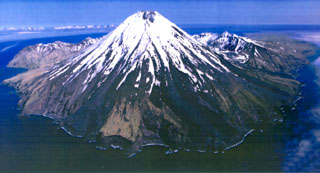Report on Kanaga (United States) — March 1994
Bulletin of the Global Volcanism Network, vol. 19, no. 3 (March 1994)
Managing Editor: Richard Wunderman.
Kanaga (United States) Intermittent low-level activity, steam-and-ash plume
Please cite this report as:
Global Volcanism Program, 1994. Report on Kanaga (United States) (Wunderman, R., ed.). Bulletin of the Global Volcanism Network, 19:3. Smithsonian Institution. https://doi.org/10.5479/si.GVP.BGVN199403-311110
Kanaga
United States
51.923°N, 177.168°W; summit elev. 1307 m
All times are local (unless otherwise noted)
Intermittent low-level activity continued in mid-March. Although ground observations from Adak . . . were limited due to poor weather, ground observers reported a moderate steam plume on the afternoon of 16 March and sulfur odors on 20 March. On 31 March, pilots and ground observers reported a vigorous steam plume containing minor ash that extended above the volcano to an estimated 3,050 m altitude. Local winds carried the plume to the N and NE, and light ashfall occurred on the flanks of the volcano. Satellite images revealed a warm spot . . . as well as a faint plume headed N, consistent with pilot reports. Observers in Adak reported no significant ashfall in March.
Residents of Adak reported that poor weather obscured Kanaga during the first half of April. The FAA and NWS logged no pilot reports of continuing eruptive activity at Kanaga through mid-April. Naval weather observers in Adak reported steam and ash rising a few hundred meters above the volcano on 12 April. Adak residents also reported a very strong sulfur smell during the second week of April.
Geological Summary. Symmetrical Kanaga stratovolcano is situated within the Kanaton caldera at the northern tip of Kanaga Island. The caldera rim forms a 760-m-high arcuate ridge south and east of Kanaga; a lake occupies part of the SE caldera floor. The volume of subaerial dacitic tuff is smaller than would typically be associated with caldera collapse, and deposits of a massive submarine debris avalanche associated with edifice collapse extend nearly 30 km to the NNW. Several fresh lava flows from historical or late prehistorical time descend the flanks of Kanaga, in some cases to the sea. Historical eruptions, most of which are poorly documented, have been recorded since 1763. Kanaga is also noted petrologically for ultramafic inclusions within an outcrop of alkaline basalt SW of the volcano. Fumarolic activity occurs in a circular, 200-m-wide, 60-m-deep summit crater and produces vapor plumes sometimes seen on clear days from Adak, 50 km to the east.
Information Contacts: AVO.

